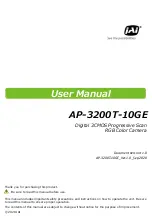
V1.0.1 - 10 -
Yantai IRay Technology Co., Ltd.
11th Guiyang Street, YEDA
Yantai 264006, P. R. China
2
)
Select the right monitoring scenario
Avoid using infrared cameras in environments with large areas of high temperature
objects (such as electronic billboards, large area light boxes, glass walls that are
exposed to the sun, etc.). These hot objects may cause false alarms or missed alarms.
3
)
The ground of the monitoring site should not be too smooth
Avoid the temperature rise and fall caused by the airflow disturbance on the skin
surface of the person being tested, which will affect the false alarm or leakage of the
infrared thermometers.
4
)
Reserve a long enough channel
Prevent the person being tested from entering the room and testing directly in a hot /
cold outdoor environment. Since the skin temperature is higher or lower than real skin
temperature when they first enter a room with a constant temperature from a hot / cold
outdoor environment, at this time, a long enough channel needs to be reserved to allow
the subject's body surface temperature to gradually stabilize before testing, to avoid
false alarms or missed alarms of the infrared camera.
3.6 Parameter Setting Guidance
Atmospheric temperature:
set according to the site environment temperature.
Reflection temperature:
if there is no hot object in the environment, set it to the
environment temperature.
Emissivity:
if the body temperature is measured, it is recommended to set it to 0.98.
Atmospheric transmittance:
for indoor or better visibility, keep the default
parameter 1.
Distance:
set according to the conditions of use, default 2m.
Temperature measurement mode:
the standard mode and the human body
temperature measurement mode are provided for selection. The temperature measured
in the standard mode is the real temperature. The temperature measured in the human
body temperature measurement mode is the internal temperature of the human body
calculated from the skin surface temperature.



































